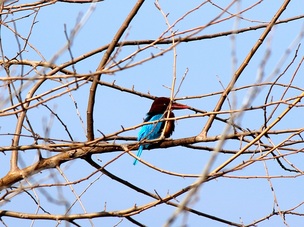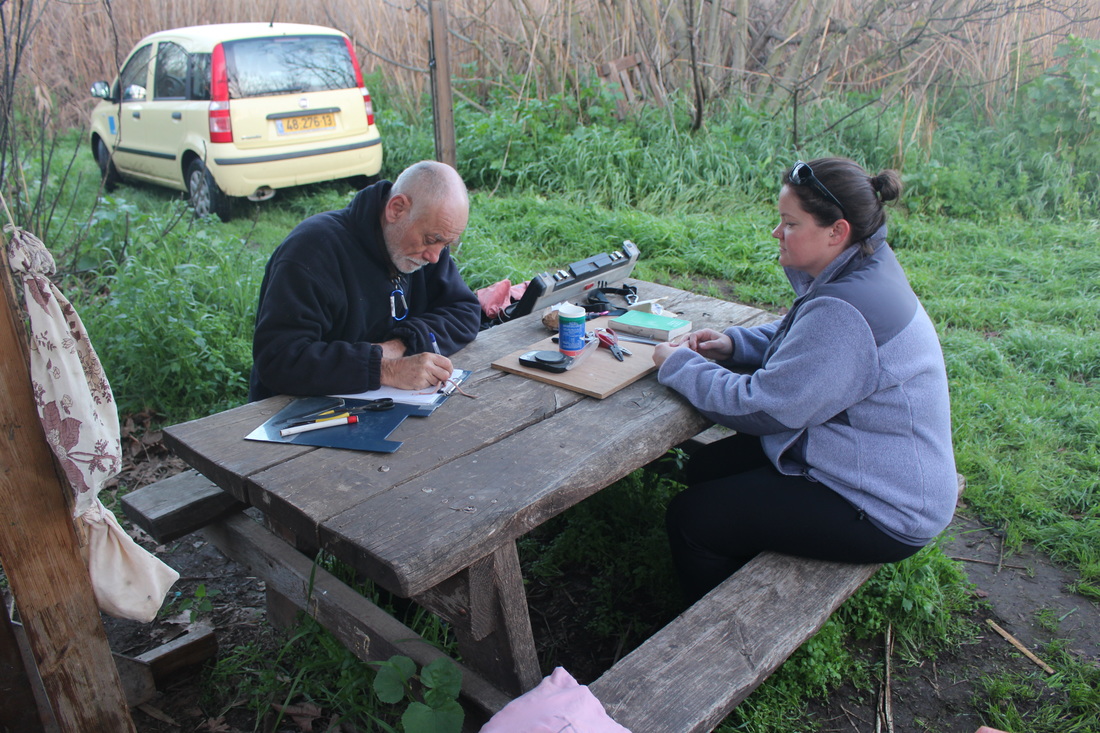
This is an old post that was half finished when I was in Israel. I decided to post it before I forget.
Joey and I had the amazing opportunity to band birds and spend some time in the Hula valley. The Hula is an incredible place and has the reputation of being a birder’s paradise and rightly so. It is a wet, green valley between two mountain ranges, the Golan Heights to the east and the upper Galilee’s Naftali mountains to the west, and is a major stop over point for the bird migrations from Europe and Asia to the Middle East and Africa. The Hula used to a marshy wetland but most of it was drained and converted to farmland in the 50s and 60s. Eventually the value and uniqueness of this habitat was recognized and several areas were re-flooded and made into a protected area and a reserve in the 1990s. Yoni does most of his research on nutria (a large invasive rodent that looks a little like a beaver) in the reserve. Today over 500 million migrating birds pass through here each year.
Joey and I had the amazing opportunity to band birds and spend some time in the Hula valley. The Hula is an incredible place and has the reputation of being a birder’s paradise and rightly so. It is a wet, green valley between two mountain ranges, the Golan Heights to the east and the upper Galilee’s Naftali mountains to the west, and is a major stop over point for the bird migrations from Europe and Asia to the Middle East and Africa. The Hula used to a marshy wetland but most of it was drained and converted to farmland in the 50s and 60s. Eventually the value and uniqueness of this habitat was recognized and several areas were re-flooded and made into a protected area and a reserve in the 1990s. Yoni does most of his research on nutria (a large invasive rodent that looks a little like a beaver) in the reserve. Today over 500 million migrating birds pass through here each year.
One of the most amazing things in the Hula is definitely the cranes. The European gray cranes over winter in the Hula valley from their northern breeding grounds across Europe. The Hula is thought to be one of the main wintering habitats for them in the world. When most of the Hula was farmland, a couple thousand cranes could be found over wintering there each year, they did significant damage to crops as they flocked and fed in farmers fields. A solution had to be found for the farmers and cranes to coexist. They decided to flood several fields near lake Hula and to feed the cranes (peanuts and chickpeas) in this designated area. They also use loud booming sounds to scare the cranes from farmer’s fields into this crane area. It works marvelously. Today the population of cranes has grown from a few thousand to over 30,000 cranes each year. They can make quite a racket and it is truly incredible to witness. They are also a huge tourist attraction in Egypt.
The people managing the Hula reserve do lots of bird monitoring and one of the ways they do this is with a passive bird banding station, which means they set up lines of nets at dawn in a corridor they have cleared out in the reeds and catch, band, and measure whatever flies into them. By doing this year after year, it gives them some sense of populations and species that are using the Hula, as well as lots of other cool data. We were invited to help one morning with the banding, the majority of which is run by a man named Francis. Let me take a second to describe Francis. He is a retired British pensioner who has traveled around the world looking for and catching birds. He has a life list like you would not believe. He is a serious British birder and spends all of his retirement running banding stations. He informed me over the phone when I called to let him know that we were joining him that we were not going “banding” we were going “ringing”, as this is the European term. I stand corrected. We met him at the gates of the reserve at 5:15am the next morning. He picked us up in a tiny rental fiat and was concerned that it was already getting late. He preceded to drive like a crazy person to the ringing station. As he was careening down the road, he informed Joey and I that if you hit the speed bumps at an angle, it is much better. The road to the ringing station itself was dirt tire tracks through tall grass. As he whipped onto it he informed us that he must go very fast or he would get stuck in the mud. And fast he went, bouncing and splashing though giant mud holes. We may have hit our heads on the ceiling a few times, but we arrived in one piece, miraculously and opened the many nets that had been set up and closed the night before.
It was a beautiful morning and it was wonderful to get to hold and see up close so many different bird species. Our work with the swallows only brings us in contact with 2-3 different types of birds that typically live around humans. Francis was a quiet and very serious birder and I am afraid Joey and I were a bit of a disappointment to him. We may be bird scientists, but we are not birders of any caliber. He would hold up a tiny European warbler and ask us what species it was. When we did not know, he would offer us a hint by telling us the Latin family name. This was not helpful to us in the least. After doing this three or four times he finally gave up and just told us their names. The early morning was totally worth it. I guess there are some perks to being an ornithologist abroad.


 RSS Feed
RSS Feed